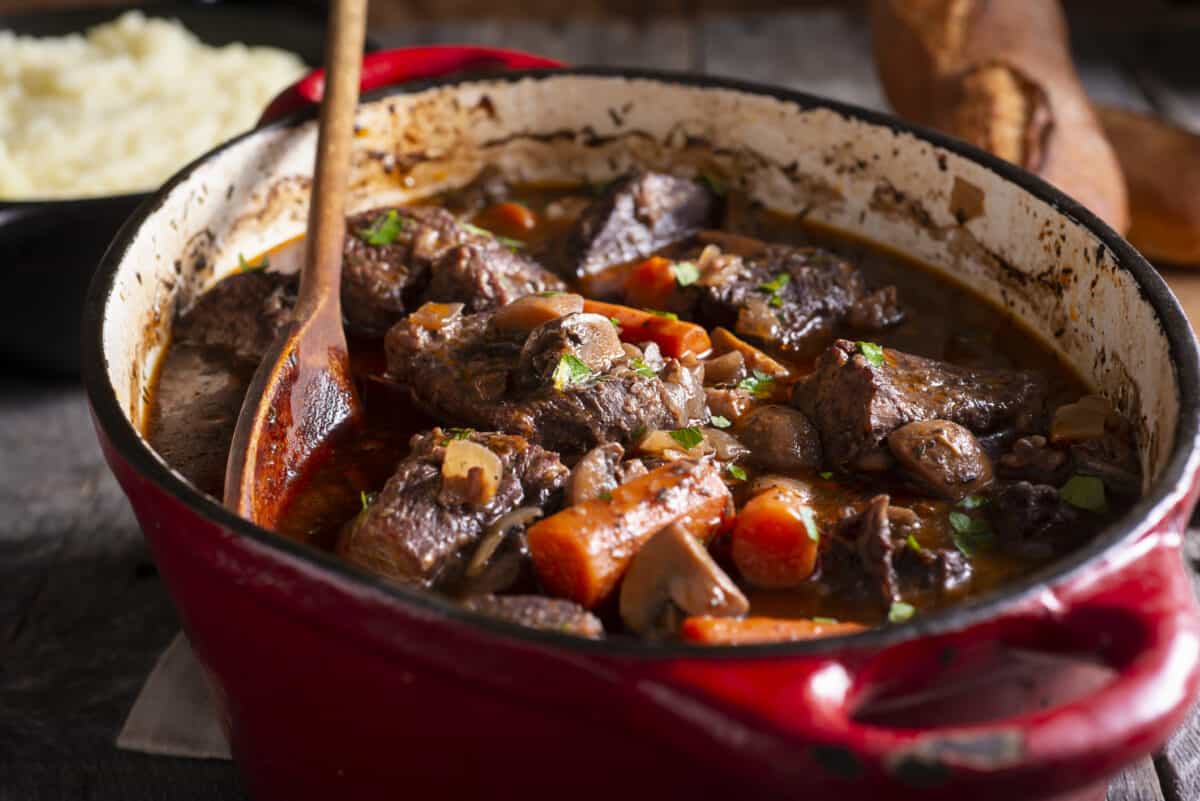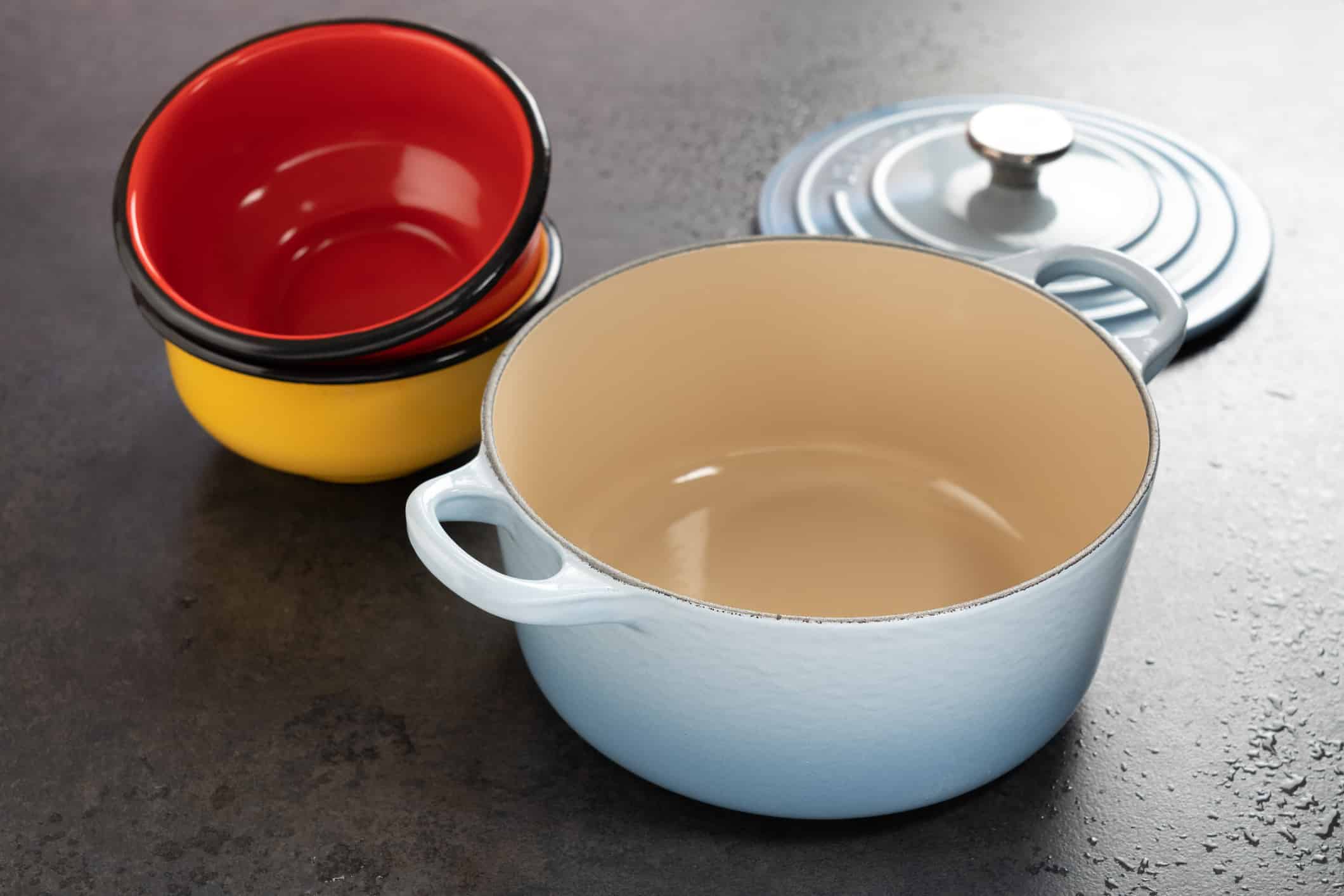Depending on where you are in your culinary journey, you may or may not have an enameled cast iron pan in your cooking arsenal. It’s a unique type of cookware that has its uses, but it’s not for everyone. Today, we’re going to tell you a bit about this material and why you should avoid cooking with enameled cast iron.
What is Enameled Cast Iron?
Before we get into why you should avoid cooking with enameled cast iron, let’s talk a bit about what it is. Essential, enameled cast iron is cast iron that’s been coated with a layer of enamel. The enamel is key to creating a non-porous, smooth, and non-reactive cooking surface. We’ve talked about the reasons to avoid regular cast iron in the past, and a major reason is that the cookware has to be constantly seasoned to keep food from sticking and avoid damaging the pan. Enameled cookware eliminates that issue and a few other problems created by cast iron.
Enameled cast iron comes in a variety of colors, and it can add a nice touch to a kitchen, but it’s also much more expensive than regular cast iron, usually coming in at a few hundred dollars a pop. The big perk is that the enamel version takes a lot less work to care for and clean than regular cast iron, and there’s almost no limit to the types of food that can be cooked.
Reasons to Avoid Cooking With Enameled Cast Iron
The price aside, you may be thinking that enameled cast iron seems like a pretty good deal so far, and it does have its perks, but there are also a number of downsides.
1. It’s Heavy
Just like regular cast iron, enameled cast iron is very heavy. It’s the heaviest type of pan on the market, and a big pan can max out at 12 pounds. Even the smaller versions will weigh four pounds. This cookware is not for flipping pancakes. Keep in mind that is the pan’s weight without having any food or liquid inside. However, it is sturdy, and if well maintained, it will last for years.
2. Able To Crack When Not Properly Cleaned
If you don’t maintain and clean enameled cast iron properly, it can experience thermal shock. Essentially, that’s when you wash a still-hot pan in cold water. Do that enough, and the enamel can begin to expand and shrink rapidly, which leads to cracking and breakage. Small cracks can quickly grow, and over time, the pan could become useless. If you decide to buy enameled cast iron, let it cool down before washing. Also, never take the pan out of the fridge and put it directly in the hot oven.
3. It Can Chip And Be Forever Destroyed
Again, enameled cast iron is heavy, so try before you buy. If you don’t think you can properly hold and maneuver the cookware, then don’t invest in an expensive pan. The problem is that if you drop it or hit it against the counter, the enamel can easily break, and the cast iron underneath will be exposed.
In addition to impacting the look of the cookware, it also creates a permanent problem. Once pieces of enamel start chipping off, you should stop using the pan completely because other pieces can break off easily and fall into your food. Even a small scratch can expand quickly over time, so be careful.
4. A Hard, Rough Bottom
Although the cast iron pan is completely covered in enamel, it still usually has a hard bottom that can damage and scratch your counters and oven if you’re not careful. Like most other types of pans, you should never drag it across any surface.
5. Difficult to Clean
You cannot put an enameled cast iron pot in the dishwasher. It must be hand-washed. When you do, keep in mind that not every inch of the pan is enamel. Often, the rim of the pan will be exposed metal. If you’re not careful, that area can rust, so you must dry it completely before storing it in the cabinet. Even if the pan says it’s dishwasher-safe, it’s wise to hand wash because the detergent can wear down the enamel over time.
6. Food Still Sticks
In addition to looking nice, the enamel covering is meant to keep food from sticking, and although it does that fairly well, it’s not completely non-stick. To get that, you’ll want to buy a traditional non-stick pan. For enamel, you’ll still need to add a thin layer of butter or oil to prevent your food from sticking.
7. It Takes Long To Heat
Enameled cast iron is gorgeous, but it’s big, and it’s thick and so it’s generally a slow-heating dish. It will heat much slower than aluminum and other non-stick pans. With that said, when it gets hot, it's very hot, so don’t forget to touch it without gloves or you’ll hurt yourself.
Since the cookware is all one piece, the handles can also get exceptionally hot. It can be easy to forget, but wear oven mitts, or you could be badly burned.
As a final caveat, be aware that the pan may not heat evenly at first. It’s best to preheat the oven first and then add the pan for an even heat.
8. It’s Expensive
As mentioned, enameled cast iron is very expensive. It’s much more expensive than standard cast iron. The cost could be several hundred dollars for standard models and much more for high-quality models that are made in France.
Are There Any Benefits to Enameled Cast Iron?

Enameled Cast Iron is often compared to a Dutch Oven and can be used for similar applications.
©iStock.com/rudisill
So far, we’ve given you many reasons why you should avoid cooking with enameled cast iron, but are there any benefits to this type of dish? There are a few.
It’s Gorgeous – We may have issues with how it cooks, but there’s no denying that enameled cast iron is quite beautiful. You can get it in many different colors and designs, so it can be a great compliment to a kitchen.
Relatively Easy to Clean – Although you do need to hand wash enameled cast iron, the enamel is smooth, which makes it relatively easy to clean. Even the exposed metal can be cleaned with paper towels.
Can Cook Acidic Foods – Unlike regular cast iron, you can freely cook acidic food without much worry about bad taste or wearing off the coating on the pan.
It Can Last Generations – When it’s properly cared for, enameled cast iron can last many years and even generations. It’s something family can pass down, and that’s pretty cool.
What to Use Instead of Enameled Cast Iron
Now that we tell you to avoid cooking with enameled cast iron, what can you choose instead? You have a few options:
Casserole Dish – It’s very similar to enameled cast iron and even a dutch oven. It’s a slow-cooking dish that also looks good in a kitchen.
Skillet – It’s great for searing, sauteing, and frying. Plus, it can be used to cook a roast in the oven. As an added benefit, it has oven-safe handles.
Frying Pan – Put a lid on a frying pan, and it can work as effectively as enameled cast iron. As you cook, you can continue to add ingredients, and it all cooks easily.
Standard Cast Iron – Regular cast iron will often heat faster than enameled cast iron, and it has many applications. However, it’s also heavy and requires seasoning whenever you use it.
Conclusion
These are the reasons to avoid cooking with enameled cast iron, along with some tips to help you along the way. Although there are negatives, some cooks may like this type of cookware, and if you like what you see, then consider a try. Complete some research ahead of time and make the right choice for your kitchen.
The image featured at the top of this post is ©EGT/ via Getty Images
